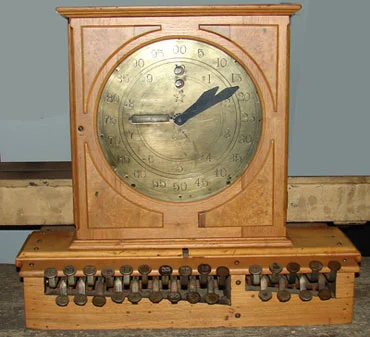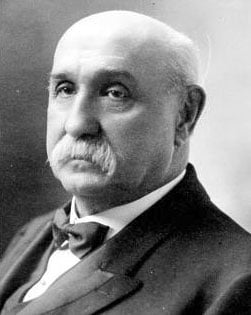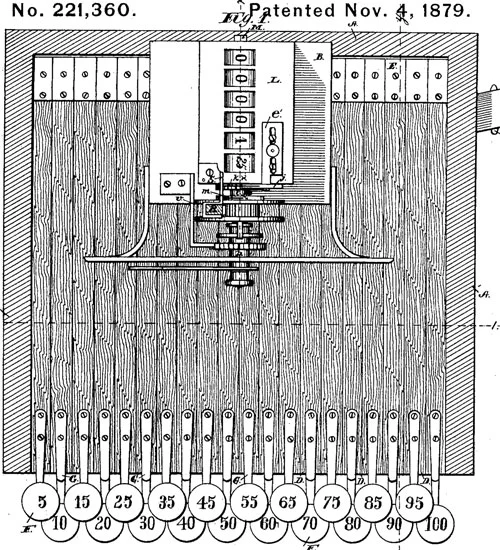When Were Electronic Cash Registers Inveneted

The History of the Cash Register: A Complete Guide
The cash register may be part of all of our business experiences, but for its time period, it was actually highly revolutionary. Indeed, the cash register didn't first come into existence until 1879, when James Ritty, a saloon owner in Dayton, Ohio invented it. Ritty grew tired of having his profits stolen by less-than-scrupulous bartenders. He invented the register as part of an effort to track his funds and keep track of how much money he made. The device was a purely mechanical one and designed to track income, not to give change, although that evolution would come with time.
Ritty sold his interests in his company to a business that would eventually become the National Cash Register Company. Founded by John Patterson, the National Cash Register Company would become the major driver of the cash register in the late 19th and early 20th century, eventually turning Patterson into a very rich man.
After its sale to John Patterson and NCR, the register began to evolve into a highly profitable and lucrative business. This happened as mechanical improvements occurred to the device. This included the addition of a paper receipt, additional push buttons to input various denominations of currency, the addition of slots for both coin and paper currency, and displays that could allow customers to see how much they were being charged. Advanced models would go as far as automatically making change for individuals, and some of these machines are still sold today.
Further evolutions on the device continued into the 20th century, as the device shifted from a purely mechanical one to a hybrid that incorporated electric motors. Indeed, the National Cash Register Company would become the leading innovator and seller of the device, eventually evolving into the Class 1000 register, a device that stood the test of time and was sold well into the 1950s.

The Cash Register: Everything to Know
Modern cash registers have evolved extensively from the devices that were first available, and these changes have been instigated by the rapid evolution of the way that we handle financial transactions.
Cash is still used, of course, and while its use is not as extensive, modern cash registers have to still be prepared to deal with these transactions. There is a slew of different models now available, but comprehensive cash registers have evolved past their mechanical predecessors and into a device that is more commonly referred to as a Point of Sale System. These high-end devices are equipped to handle multiple forms of sales. They typically come with the ability to ring up sales and take those sales in any number of methods of payments, including Cash. Digital or touch screen inputs can be used to input the amount of cash received and the amount of cash owed, and these numbers are displayed for both the store clerk and the customer, thus ensuring accuracy.
Starting in 1962, cash registers evolved to the point that they could take input from manual credit card processing devices. Later years would see the continued evolution of these devices, eventually allowing credit cards to be automatically used for sales and rung into cash register systems.
More recent years have seen the incorporation of new credit card payments and near field communication credit cards. They have also changed to allow for digital, touch-screen input for customers and the ability to receive a receipt via text message or email, rather than print.
Cash Register Specs
The cash register has evolved significantly from its mechanical roots. Indeed, there are many different versions of the device that are available today. However, these devices can be broken into roughly two types of types.
Cash Registers
While Point of Sales Systems can provide nearly total control and monitoring of a slew of cash systems, regular registers can still provide a wide array of functions. Most of these devices are digital: They come with a series of buttons that allow for a cashier to input the sales of a product, ring up a sale, and then give change. They usually come with some form of integration with credit card payments, meaning that a credit card purchase can be easily rung up. Furthermore, they will print a receipt and record one internally, thus allowing for customers to have a record of their transaction.
Point of Sales System
Point of Sales Systems are a far more advanced version of the cash register than anyone could have ever dreamed of. They have all of the same features as a more common register above but also come with a series of additional features, including integration with an inventory management system, advanced business analytics, the ability to send a receipt digitally, and a scanner to scan a barcode and automatically ring up a purchase.
Cash Register: Where to buy
The cash register and its successor, a Point of Sale system, are no longer the domain of one exclusive company. While they can still be purchased from NCR (formerly known as National Cash Register), they are available from an almost overwhelming array of businesses. They can also be purchased from almost any major website, including Amazon, Office Depot, and Staples. The price of the register will vary widely: Less expensive models can cost as little as $425, while advanced, Point of Service Systems can go for as high as $1100.
The History of the Cash Register: What To Know
The cash register was first released in 1883, when it was invented by James Ritty, a bar owner in Dayton, Ohio. Ritty invented the device as a response to employee theft. He got the idea while on a steamship and finding a device that tracked the rotations of the ship's rotors.
His idea was borne of necessity. Ritty ran a bar in Dayton and was the regular victim of theft by his employees. Thanks to this device, Ritty was able to track sales. For assistance, James turned to his brother, John, who was more mechanically inclined. The two invented the Incorruptible Cashier and began selling the device as the first commercially available register.
James could not manage both the cash register business and his saloon and sold the patent for the device in 1884 to John Patterson. Patterson would form the National Cash Register Company, and it was he who popularized the device.

Cash Register Versions: Each Edition
Like with any major device, the timeline of the register has evolved extensively as the device became more and more popular and in demand. A variety of different models are now available, but the below can provide a good summary of the various versions of the register.
The timeline of the register has clearly lent itself to more and more features and increased popularity. Indeed, the device's timeline has now evolved far beyond the device's original purpose.
Ritty's Incorruptible Cashier
This was the first ever cash register. It had buttons, an internal tracker, and the ability to store money, complete with a bell that went off whenever a sale was rung up. Its main purpose was to stop employee theft.
It should also be noted that this device did not include virtually any of the systems that we commonly associate with cash registers today, including displays of how much change to give or receipts for customers.
Class 1000
For the first half of the 20th century, the Class 1000 register was essentially the most common register on the market. It included modern convivences that we associate with the cash register today, including receipts for customers, displays that showed the price of a product, locks for registers, tracking of why a register was opened, and the printing of itemized receipts.
The advanced information on this device made it easier for business owners to trace their purchases and compare them against inventory, thus making the device more useful for loss prevention purposes.
NCR 390
Another popular version of the cash register was the NCR 390. This was not a cash register per se, but it was the first ever mass marketed computing device. It was subsequently placed inside of registers in order to convert these registers to digital devices, thus enhancing the features and speed of the cash register.
Cash Register: The Public Response
The register made a relatively small impact on the public, as it was not used frequently at first, and then slowly introduced. The invention of the device was more noticed by business owners who were grateful to have the business tool and added check against employee theft.
Cash Register: The Complete History FAQs (Frequently Asked Questions)
When was cash register invented?
The first cash register was invented by James Ritty in 1879. It was known as the Ritty Model 1 and patented in 1883 as Ritty's Incorruptible Cashier.
When did the cash register first come out?
The first register came out in 1879 and was patented in 1883.
What was the original price of the cash register?
The original retail price of the first cash register is unknown. However, when James Ritty sold the patent and his cash register business to John Patterson in 1884, he sold it for $6,500. That's the equivalent of $181,447.50 in today's dollars.
Who invented the cash register and why?
The first cash register was invented by James Ritty. He invented it after his growing frustrations with dishonest bartenders who would reach into the "till" and help themselves to his profit. A cash register could serve as a register of charges and help ensure that no one could steal his profits without being caught.
How did the first cash registers register a transaction?
Cashiers would input the amount of money received and then place that money in a drawer. That transaction would then be recorded after the cashier hit a "total sale" button.
How did the cash register impact society?
Unlike some devices, the cash register's impact on society was more nuanced, although it was more pronounced for some sectors. Business owners could purchase a cash register as a deterrent against theft, thus making their lives easier. It also led to advances in bookkeeping, as the receipts could be used to determine a business's overall level of profit and if they were even making any money.
How did the first cash register work?
The first cash register came with buttons and taps. Cashiers would ring up a total sale by pressing the buttons that would indicate the amount of cash received. From there, the drawer would open, and cashiers would place the money in the drawer. A device inside the machine would add up the total amount of keys pressed during the day, thus enabling a business owner to determine the days' sales and whether or not there was any missing money.
It's worth keeping in mind that the first cash registers were simply designed to serve as glorified adding machines. In their original form, they didn't even show customers how much change they were owed – that innovation would come later.
As an added incentive against theft, early cash registers came with a bell. This bell would ring whenever the drawer was opened, thus allowing a cashier access to the cash drawer, or till. The theory was that the ringing of the bell would call attention to the opening of the cash drawer, thus making it harder for a dishonest employee to steal from it.
When Were Electronic Cash Registers Inveneted
Source: https://history-computer.com/cash-register-complete-history/
Posted by: penaseemase.blogspot.com

0 Response to "When Were Electronic Cash Registers Inveneted"
Post a Comment